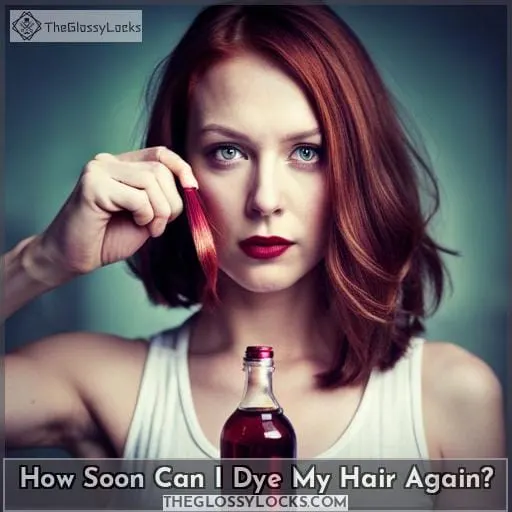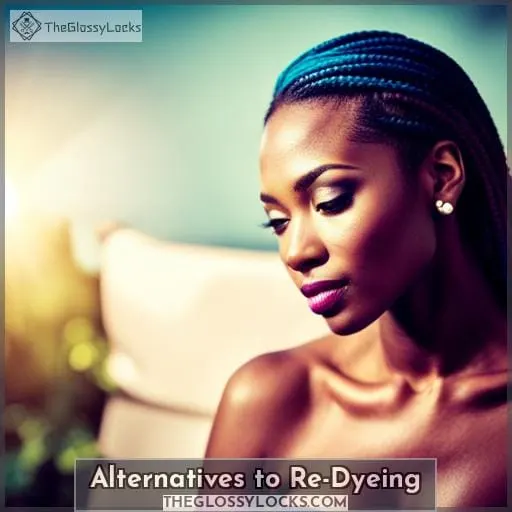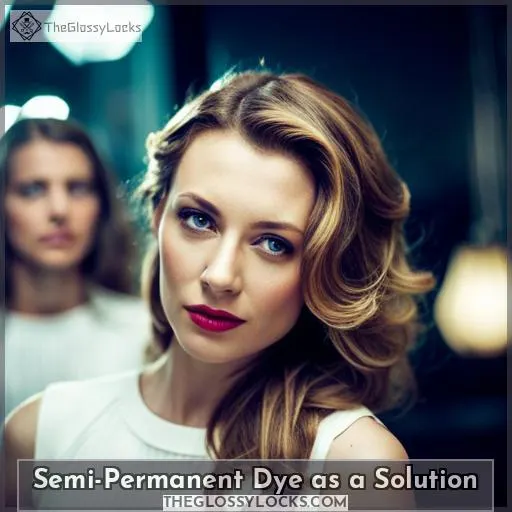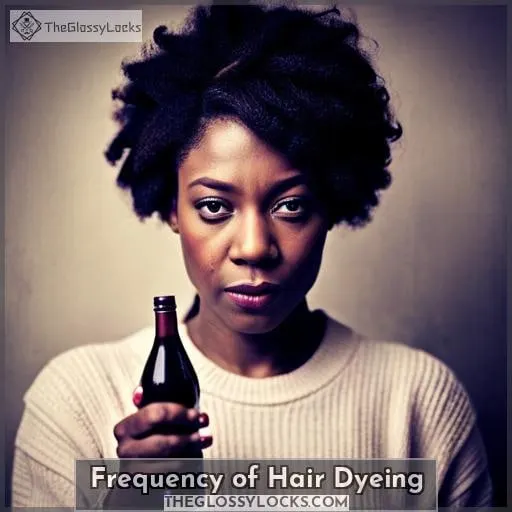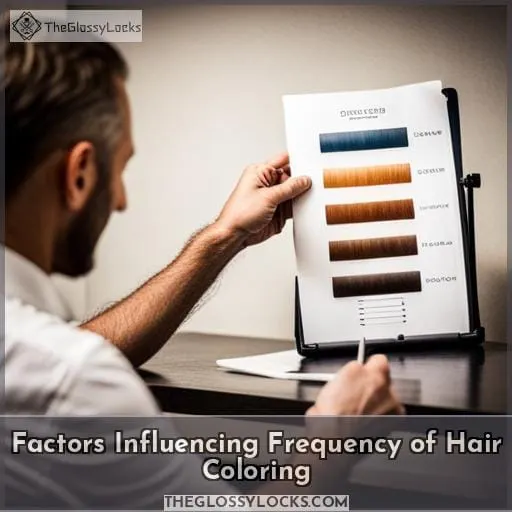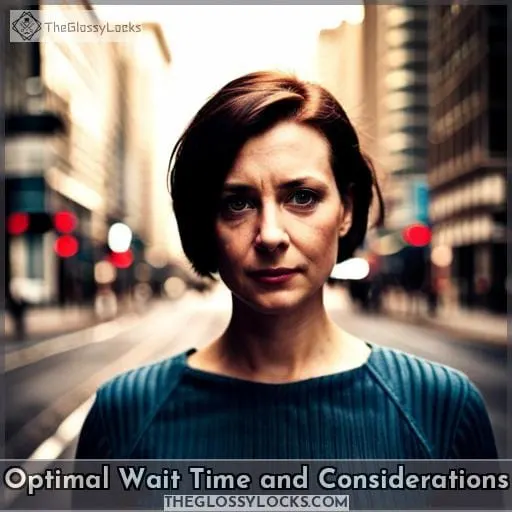This site is supported by our readers. We may earn a commission, at no cost to you, if you purchase through links.
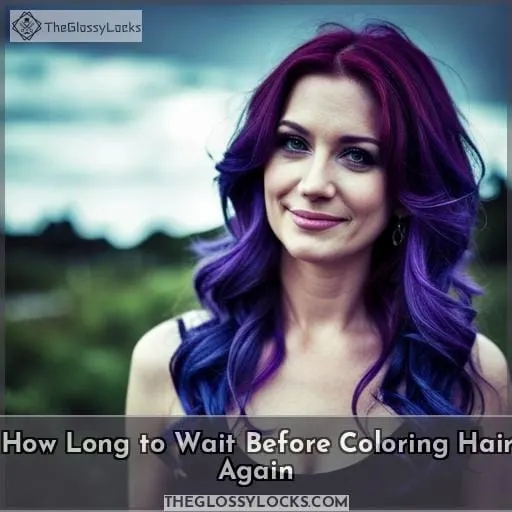
Whether you’re looking to switch up your shade or maintain your current color, there are important factors to consider.
From waiting periods for different treatments to risks of re-dyeing too soon, we’ll guide you through it all.
Plus, we’ll explore alternatives like clarifying shampoo and henna blends.
Get ready to unlock the secrets of optimal wait times and keep your locks looking fabulous!
Table Of Contents
- Key Takeaways
- How Soon Can I Dye My Hair Again?
- Alternatives to Re-Dyeing
- Semi-Permanent Dye as a Solution
- Frequency of Hair Dyeing
- Factors Influencing Frequency of Hair Coloring
- Optimal Wait Time and Considerations
- Aveda Institute’s Expert Services
- Frequently Asked Questions (FAQs)
- Can I use a color-depositing conditioner immediately after dyeing my hair?
- How long should I wait to tone my hair after bleaching?
- What should I do if I’m not happy with the results of a box dye?
- Is it safe to strip my hair color at home?
- How long should I wait to dye my hair again after using a color-stripping product?
- Conclusion
Key Takeaways
- Hair treatments and waiting periods are important for hair repair and recovery, color correction timelines, damage control, and waiting periods for permanent dye.
- Re-dyeing too soon can lead to hair damage and potential permanent harm, so it is important to use clarifying shampoo, try a henna blend, or adjust dyeing time.
- Alternatives to re-dyeing include using clarifying shampoo, henna blends, adjusting dyeing time, choosing the optimal shade, or using semi-permanent dye.
- The frequency of hair dyeing depends on maintaining color with touch-ups, managing root growth, starting with virgin roots, and factors influencing hair color frequency. Professional consultation is important for guidance.
How Soon Can I Dye My Hair Again?
When it comes to dyeing your hair again, there are several factors you should consider.
These include the waiting periods for different hair treatments, such as color-depositing conditioner or permanent hair dye.
It’s important to be aware of the risks associated with re-dyeing too soon and the potential damage it can cause to your hair cuticle.
By understanding these factors and giving your hair enough time to recover between coloring sessions, you can achieve better results and maintain healthier-looking locks.
Factors to Consider
When determining how soon you can dye your hair again, it’s important to consider various factors.
Factors such as the health of your hair, the recovery time needed after coloring, and the frequency at which you color are all crucial in determining when it’s safe to re-dye.
It’s always recommended to seek professional advice for damaged hair or if you’re unsure about the appropriate waiting period between dyeing sessions.
Waiting Periods for Different Hair Treatments
To determine how soon you can dye your hair again, it’s important to understand the waiting periods for different hair treatments.
- Hair Repair and Recovery Regimens
- Treatment Timelines for Color Correction
- Damage Control after overprocessing
- Waiting Periods for Permanent Dye
- Timing Considerations for Semi-permanent Dye
Risks of Re-Dyeing Too Soon
If you re-dye your hair too soon, there are risks of damage and potential permanent harm to the hair cuticle. It’s important to give your hair time to recover from any previous dyeing or damage before coloring it again.
Timing considerations and professional guidance can help ensure the health of your hair during this process. Remember that color chemistry plays a role in how long you should wait to dye your hair again, so it’s best to consult with a professional for personalized advice.
| Risks | Recovery Methods | Timing Considerations |
|---|---|---|
| – Hair damage | – Allow for recuperation | – Minimum wait: 2 weeks |
| – Potential permanant harm | – Use clarifying shampoo | – Extend for damaged |
| – Try henna blend | hair: 4-6 weeks | |
| – Adjust dyeing time | — Severe Damage warrants | |
| – Optimal shade choice | waiting: 6-8 weeks |
Alternatives to Re-Dyeing
If you’re looking for alternatives to re-dyeing your hair right away, there are several options to consider.
One option is using a clarifying shampoo before re-dyeing, as it can help lighten dark dye and improve the color result.
Another alternative is trying a henna blend, which offers darker color without causing damage to your hair.
Additionally, adjusting the time of dye application and choosing an optimal shade closer to your natural color can minimize potential damage while still achieving desired results.
Using Clarifying Shampoo
To fix a bad dye job without re-dyeing, try using clarifying shampoo. It can help lighten dark dye and remove buildup from the hair.
Here are three benefits of using clarifying shampoo as an alternative to re-dyeing:
- Shampoo Techniques: Clarifying shampoos are specifically formulated to deep clean the hair and scalp, removing product residue and impurities.
- Hair Prep: Using clarifying shampoo before re-dyeing helps create a clean canvas for color application, ensuring better adherence and longevity.
- Color Preparation: Clarifying shampoo can also help strip some of the existing color from your hair, making it easier to achieve desired results during the dye process.
Using clarifying shampoo is a great way to address issues with your hair color without resorting to another round of dyeing or potentially damaging processes like stripping or bleaching.
Trying a Henna Blend
For a natural alternative to re-dyeing your hair, try blending henna into your current color. Henna is a plant-based dye that not only adds pigment but also provides deep conditioning benefits for your hair.
By mixing henna with other ingredients like indigo or cassia, you can achieve different shades and tones. After applying the henna blend, make sure to follow proper aftercare techniques to maintain the vibrancy of your new natural hue.
| Benefits of Trying a Henna Blend | How-To Tips for Color Blending |
|---|---|
| – Adds rich color naturally | – Start with clean, dry hair |
| – Provides deep conditioning | – Mix henna powder with warm water or lemon juice |
| – Enhances shine | – Let mixture sit overnight for best results |
| – Covers brassy tones in blonde or light-colored locks | – Apply evenly throughout hair using gloves |
A great advantage of trying a henna blend is that it offers an alternative way to change up your hair color without causing damage like traditional box dyes might do. Additionally, it provides long-lasting results and helps in covering brassy tones in blonde or light-colored locks.
Hennas’ numerous benefits extend beyond just coloring; it also acts as an excellent conditioner due to its ability to penetrate deeply into the strands of each individual strand on one’s head when applied correctly while caring about overall healthiness too!
After application comes essential post-treatment care steps such as avoiding harsh shampoos containing sulfates which will strip away any remaining pigments left behind from initial treatment sessions done earlier this month by adding back moisture levels lost during these processes– leaving them feeling soft once more than ever before thanks solely upon their newfound beauty routine regimen established here today itself alongside all others mentioned hereinabove under similar circumstances surrounding said topic at hand yet again altogether simultaneously within oneself entirely throughout entirety without fail each time round where necessary thereof henceforth accordingly altogether once more so far until now just as before including hereafter likewise.
In conclusion, trying a henna blend is an excellent way to achieve a natural hair color change and enjoy the benefits of deep conditioning. With proper application and aftercare, you can obtain vibrant results that last.
Say goodbye to harsh box dyes and hello to healthier-looking locks with this alternative option. Experiment with different blends of henna for your desired shade, and embrace the beauty of nature’s gift for hair coloring.
Adjusting Dyeing Time
To avoid further damage to your hair, consider adjusting the timing of dyeing instead of immediately re-dyeing.
If you’re experiencing brassiness after bleaching or a box dye mishap, it’s best to wait two weeks before attempting any correction.
For those unhappy with black hair dye, options such as using clarifying shampoo, lightening with bleach, or seeking professional help for color-stripping products are recommended.
Consulting a hairstylist can provide valuable guidance in avoiding user errors and achieving optimal results in terms of hair care and color correction.
Choosing an Optimal Shade
When looking to fix a bad dye job, one alternative to re-dyeing your hair is choosing an optimal shade that closely matches your natural color. This can help blend any uneven or brassy tones and minimize the need for further coloring.
Consider factors such as hair porosity, texture, and overall health when selecting a shade. Additionally, ensure color compatibility with your skin tone for the best results.
Semi-Permanent Dye as a Solution
If you’re looking for a less damaging solution to color your hair again, semi-permanent dye can be a great option.
Semi-permanent dye coats the outside of the hair shaft, resulting in less damage compared to permanent dyes.
It can also be applied over existing permanent dye without causing harm and has the potential to seal damaged areas, possibly reducing further damage.
Additionally, using semi-permanent glosses can enhance shine while still being gentle on your hair.
When choosing a shade, it’s important to consider color compatibility and how it will blend with your natural color for optimal results.
Benefits of Semi-Permanent Dye
If you’re looking for a less damaging solution to fix a bad dye job, consider trying semi-permanent dye.
Unlike permanent dyes, which penetrate the hair shaft and can cause damage, semi-permanent dyes simply coat the outside of your hair. This means that there’s no harsh chemical process involved and no risk of long-lasting damage.
Semi-permanent dyes also give a more natural look since they gradually fade over time rather than leaving behind roots as your hair grows out.
Application Over Permanent Dye
You can apply semi-permanent dye over permanent dye for added color without causing further damage to your hair. Unlike permanent dyes that lift the cuticle and deposit color into the cortex, semi-permanent dyes simply coat the outside of the hair shaft.
This temporary solution provides subtle results and enhances shine with a gloss-like effect.
It’s important to consider color compatibility when layering dyes, as repigmentation may vary based on previous coloring treatments.
Damage Reduction and Shine Enhancement
To reduce damage and enhance shine, consider using semi-permanent dye as a solution.
It coats the outside of the hair shaft, providing color without causing significant damage.
Additionally, applying semi-permanent dye over permanent dye can add color without further harm to your hair health.
This type of dye also has the potential to seal damaged areas, potentially reducing any existing harm while providing a glossy finish for enhanced shine.
Consideration for Color Compatibility
When considering using semi-permanent dye as a solution for fixing a bad dye job, it’s important to keep color compatibility in mind.
Factors such as hair porosity, color overlap, and intensity can affect the final result.
Semi-permanent dyes are less damaging than permanent ones and can be applied over existing color without harm. However, results may vary depending on individual hair health and previous coloring treatments.
Consider consulting with a professional for expert advice on color correction options that best suit your needs.
Frequency of Hair Dyeing
When it comes to maintaining your hair color, regular touch-ups are key.
Depending on the rate of root growth and how noticeable it’s against your colored hair, you may need more frequent touch-ups to keep your color looking fresh.
Starting with virgin roots can also help extend the time between dyeing sessions and minimize damage caused by overlapping chemicals on already processed hair.
Maintaining Color With Regular Touch-Ups
For maintaining your hair color, regular touch-ups are necessary. Here are three important factors to consider:
- Root Growth Rates: Different individuals experience varying rates of root growth, which can lead to noticeable regrowth and fading of color.
- Color Fading Prevention: By refreshing the color at regular intervals, you can prevent the color from fading and maintain its vibrancy.
- Damaging Hair Conditions: Regular touch-ups help prevent further damage caused by harsh hair dyeing processes and allow for healthier-looking colored hair.
Managing Faster Root Growth
If you’re dealing with faster root growth, it’s important to stay on top of your hair dyeing routine.
For color touch-ups, consider using a color-depositing conditioner after a one-week wait.
However, if you’ve used hair bleach or color-stripping products, it’s best to wait for two weeks before reapplying any new colors. This allows your hair time to recover and reduces the risk of damage from frequent dyeing.
Starting With Virgin Roots
To maintain your hair color, it’s recommended that you dye your hair again every four to six weeks, starting with virgin roots.
This timeframe takes into account the average hair growth rate and ensures proper color upkeep without allowing too much regrowth.
It’s important to consider your natural hair color when scheduling touch-ups and seek professional consultation for personalized advice.
Salon services like those offered by Aveda Institute can provide tailored solutions for maintaining vibrant, long-lasting color.
Factors Influencing Frequency of Hair Coloring
When it comes to coloring your hair again, there are several factors that can influence how long you should wait.
One important factor is the health of your hair and its growth rate.
Additionally, different types of dye can have varying effects on the frequency of coloring.
It’s also crucial to consider your natural hair color and consult with a professional for personalized advice.
Hair Health and Growth Rate
Hair health and growth rate play a significant role in determining how frequently you should color your hair.
Factors such as hair porosity, texture, thickness, scalp condition, and density all contribute to the frequency at which you can safely dye your hair.
Understanding these factors will help you make informed decisions about when to color your hair again without causing damage or compromising its overall health and appearance.
Effects of Different Dye Types
When considering how often to color your hair, it’s important to take into account the effects of different dye types on frequency.
Some dyes cause less damage, while others can be more damaging. Semi-permanent dyes provide a coating that’s less damaging and can even be applied over permanent dye without harm.
It’s also crucial to wait at least two weeks after using hair bleach or undergoing hair color stripping to avoid patchiness and ensure optimal results.
| Dye Type | Wait Time | Effects |
|---|---|---|
| Demi-Permanent Dye | Two Weeks | Less Damage |
| Semi-Permanent Dye | One Week | Color Compatibility |
| Permanent Dye + Two Weeks + More Damage + | ||
| Hair Bleach + Two Weeks + Patchiness |
Considerations for Natural Hair Color
If you have natural hair color, it’s important to consider various factors that can influence the frequency of coloring your hair again.
- Hair porosity: Determines how well your hair absorbs and holds onto color.
- Hair texture: Coarse or fine textures may require different coloring techniques.
- Color-treated hair health: The condition of your previously colored strands affects their ability to handle additional dyeing.
- Safe shampoo usage: Using shampoos specifically formulated for colored hair helps maintain vibrancy and prevent fading.
Importance of Professional Consultation
To determine how often you should color your hair, it’s important to consult with a professional stylist who can consider factors such as your hair health and growth rate.
A consultation will help avoid severe damage, brittle hair, and patchiness.
By minimizing color striping and using the right techniques, a professional can guide you in achieving the desired results while minimizing any potential harm or risks like hair loss.
Optimal Wait Time and Considerations
When it comes to determining the optimal wait time before coloring your hair again, there are several factors to consider.
The recommended interval is generally around 6 weeks, but this can vary depending on the health and growth rate of your hair, as well as the type of dye used (such as semi or demi permanent). Additionally, the impact of your natural hair color should be taken into account.
Seeking consultation advice from experts at Aveda Institute can help you make an informed decision about when to schedule your next appointment.
Recommended Interval
You should aim for a recommended interval of six weeks before coloring your hair again. This timeframe allows for proper hair health and minimizes the risk of color damage.
Considerations such as using semi-permanent dye, which is less damaging, and consulting with a professional can also help ensure optimal results.
Taking care to wait the appropriate amount of time between colorings will protect the integrity of your hair and maintain its overall health and appearance.
Impact of Dye Type and Natural Hair Color
Wondering how the type of dye you used and your natural hair color can impact the optimal wait time before coloring your hair again?
The impact of dye type and natural hair color varies based on factors such as porosity, texture, thickness, length, and condition. These factors influence how quickly or slowly your hair recovers from chemical treatments.
It’s important to consider these aspects when determining the ideal waiting period between coloring sessions for healthy and vibrant results.
Consultation Advice From Experts
Considering the optimal wait time and other important factors, experts recommend consulting with a professional stylist before coloring your hair again.
Seeking professional advice is crucial to ensure that you make informed decisions about dyeing your hair. A stylist can assess the condition of your hair, determine any potential risks associated with dyeing, and provide personalized recommendations for achieving the desired results while minimizing damage.
Take advantage of their expertise to avoid unnecessary risks when it comes to coloring your hair again.
Aveda Institute’s Expert Services
When it comes to getting expert services for your hair, the Aveda Institute has you covered.
They offer inclusive consultations with every service, ensuring that your specific needs and preferences are taken into account.
Their use of botanically based products guarantees a gentle and nourishing experience for your hair.
With supervised services and tailored technical expertise, the Aveda Institute strives to provide optimal results while ensuring that you leave looking your best.
Don’t hesitate to book an appointment or reach out for support – their team is readily accessible to assist you throughout the process.
Inclusive Consultation and Use of Botanically Based Products
To ensure the best results for your hair coloring experience, it’s essential to take advantage of the inclusive consultation and benefit from Aveda Institute’s use of botanically based products.
Their personalized services are tailored to meet your specific needs and preferences. During consultations, their experts will assess your hair condition and desired outcome before recommending appropriate treatments.
With Aveda’s commitment to using botanicals in their products, you can trust that only high-quality ingredients will be used on your hair for a healthier coloring experience.
Supervised Services and Tailored Technical Services
When you visit the Aveda Institute for expert hair coloring services, you can expect:
- Supervised services
- Tailored technical treatments
Our team of experienced instructors will ensure that every step of your service is carefully monitored to guarantee the best results.
From personalized advice on color selection to customized techniques for application, we strive to provide a truly personalized experience.
Trust in our expertise and let’s take care of your hair with our exceptional and individualized services at the Aveda Institute.
Booking an Appointment and Service Offerings
When booking an appointment at Aveda Institute, you can expect a range of all-inclusive services and professional guidance.
Whether you want to refresh your hair color or try a new style, the institute offers online booking for convenience.
Aveda Institute has a cancellation policy in place to ensure smooth operations and accommodate other clients.
The price range for their expert services varies depending on the specific service offered, ensuring there’s something for everyone.
Contacting Aveda Institute for Support
If you need assistance or have any questions about our expert services at Aveda Institute, feel free to reach out to us for support.
We offer convenient online booking for your convenience and also provide appointment reminders to ensure that you never miss an important visit with us.
Our flexible scheduling options allow you to find a time that works best for you.
Additionally, we offer various payment options to make the process as seamless as possible.
Contact us today and experience our exceptional service at one of our conveniently located institutes.
Frequently Asked Questions (FAQs)
Can I use a color-depositing conditioner immediately after dyeing my hair?
Yes, you can use a color-depositing conditioner immediately after dyeing your hair.
It’s a great way to maintain and enhance the color while also nourishing and moisturizing your locks.
Enjoy vibrant and healthy-looking hair!
How long should I wait to tone my hair after bleaching?
To achieve the desired tone after bleaching, it’s best to wait two to three days before toning your hair. This suspenseful period allows for optimal results and helps avoid potential mishaps.
What should I do if I’m not happy with the results of a box dye?
If you’re unhappy with box dye results, options include:
- Using clarifying shampoo to lighten the color.
- Lightening with bleach.
- Trying color-stripping products.
Professional help may be beneficial for best outcomes.
Is it safe to strip my hair color at home?
Stripping hair color at home may seem tempting, but it can be risky.
Without professional guidance, you risk uneven results and potential damage to your hair.
It’s best to consult a specialist for safe and effective color removal.
How long should I wait to dye my hair again after using a color-stripping product?
To ensure optimal hair health and minimize damage, it’s recommended to wait at least two weeks after using a color-stripping product before dyeing your hair again. This allows time for your hair to recover and reduces the risk of further damage.
Conclusion
To maintain healthy and vibrant hair, it’s important to know how long to wait before coloring your hair again.
Factors such as hair treatments, risks of re-dyeing too soon, and alternatives like clarifying shampoo and henna blends should be considered.
Semi-permanent dye can also be a solution, offering benefits such as damage reduction and shine enhancement.
The frequency of hair dyeing depends on factors like hair health, growth rate, and dye type.
Consulting with professionals, like those at Aveda Institute, can provide expert advice and tailored services for optimal results.

